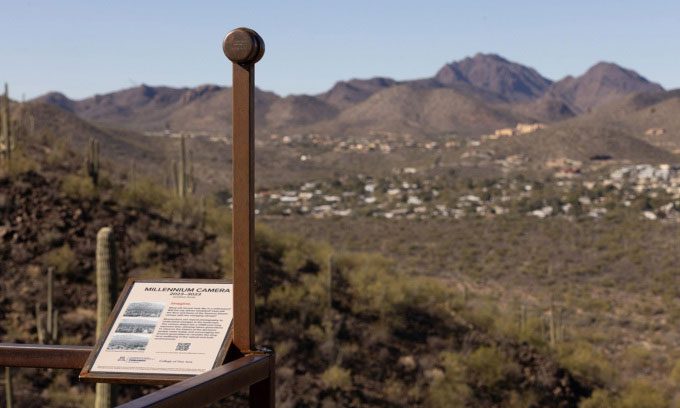A Simple Camera Designed to Capture Landscape Changes Over a Millennium on Tumamoc Hill.

Millennium Camera placed on a post at Tumamoc Hill. (Photo: Chris Richards/University Communications)
Philosopher Jonathan Keats at the University of Arizona, along with his research team at the Desert Laboratory, has developed the “Millennium Camera” project to capture the slowest photograph in the world, New Atlas reported on January 10. They placed the camera on top of Tumamoc Hill in Tucson, Arizona, to photograph the surrounding landscape with an unprecedented exposure time of up to 1,000 years.
Designing a camera that can last 1,000 years is no easy task. According to Keats, simplicity is the key to longevity. The Millennium Camera features a classic pinhole camera design. The device consists of a copper tube with a thin sheet of 24-karat gold at one end, with a small hole drilled into the gold. Light passes through that hole and projects onto a light-sensitive surface inside the camera, which is coated with several layers of a paint pigment called rose madder.
The Millennium Camera is mounted on a steel pole, positioned near a bench along a walking path on Tumamoc Hill. Next to it is a sign explaining the project’s purpose.
Over the course of 1,000 years, light reflected from the landscape will gradually affect the light-sensitive surface inside the camera. This controlled exposure will slowly blur the pigment at varying degrees. Darker areas, such as mountains, will blur more slowly than lighter areas like the sky. When future observers view the photograph, it will serve as a unique record of what has changed and what has remained the same over this period.
So what will the photograph look like? “For instance, imagine a striking case where all the houses are demolished in 500 years. At that time, the mountains will appear clear, sharp, and vibrant, while the houses will resemble ghosts,” Keats noted.
Keats plans to install additional Millennium Cameras in the area and aim them in various directions. He also intends to set them up in several locations around the world, including Griffith Park in Los Angeles, USA, sites in China, and parts of the Austrian Alps.


















































